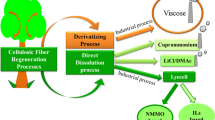Conclusion
According to an analysis of the available literature, the ALCERU method differs from the traditional viscose method due to the original characteristic of preliminary processing of the cellulose, fibre formation, and preparation of the spinning bath. Regardless of the origin of the cellulose, hydrothermal activation affects the solubility and molecular-weight distribution, as well as optimization for molecular weight.
Fibre formation with restricted drawing, i.e., with significant orientation in the spinneret channel, combined with low fibre tension in passing it through the spinning funnel, allows obtaining cellulose fibres with very good properties even at high spinning speeds. The experimentally easily attained fibre tension is an important parameter in regulation of fibre formation.
Similar content being viewed by others
References
R. Maron, Studie modifizierte Regeneratfaserstoffe, TITK, Facinformation Rudolstadt im TITK (12/1991).
Ch. Michels, H. Kramer, and E. Taeger, Papier,48, No. 3, 107–111 (1994).
Additional information
Turing Institute of Textiles and Plastics, Schwarz, Germany. Translated from Khimicheskie Volokna, No. 1, pp. 24–27, January–February, 1996.
Rights and permissions
About this article
Cite this article
Michels, C., Maron, R. & Taeger, E. Characteristics of the amine oxide process developed at the turing institute of textiles and plastics. Fibre Chem 28, 17–21 (1996). https://doi.org/10.1007/BF01130692
Issue Date:
DOI: https://doi.org/10.1007/BF01130692




